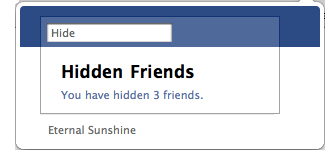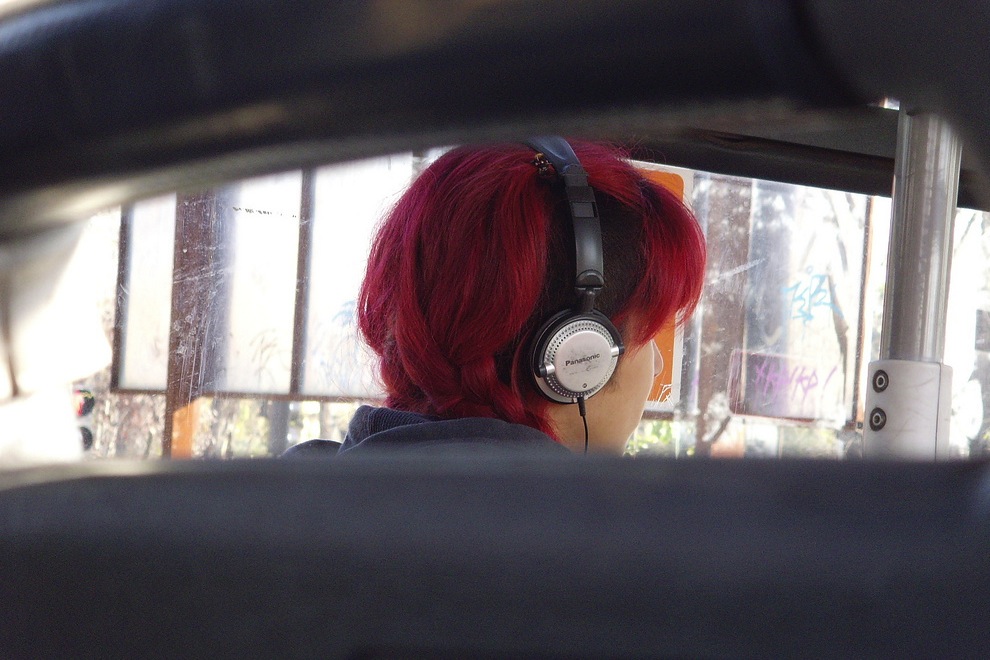This post originally appeared on OWNI, 7 March, 2011.
“Robert, I am leaving you.” In the initial moments after, all Robert could do was replay those words in his head until all the tears he could muster had spilled from his broken heart. Once the shock settled, he could throw himself into the comfort of a bottle of beer – or harder alcohol depending on the situation – to drown out his sorrows. Yet the inevitable form of cleansing was obvious, as we’ve all been Robert – he needed to burn (or at least return to the original owner) the knick-knacks, photos, love letters, and the memories that were attached to those objects. He needed to reject the one who no longer wanted him. This is not an easy step to make, but once this purging has been accomplished then the relationship is truly over.
That was before…and like everything else, yes, it was better before. Now, Robert must also mange his failed love-life in the digital world. It is nothing groundbreaking that our lives are not just physical, but also virtual. So if we raise the question whether our digital accounts will affect the grieving process of friends and family after out death, the same inquiry can be applied to breakups. Social networks have permanently changed the situation, making breakups more painful. A US marketing agency tried to create “break up with your ex day” on the same day as Valentine’s Day: time to turn the page, unfollow, untag, block, and move on! Wise decision, but breaking digital connections are not the same as breaking ties in real life. The digital world constantly reminds the most desperate and nostalgic of their misfortunes.
Facebook: the heroine for breakups

Lucy* had been dumped, and was too quick to take the decision to cut off her torturer from her Facebook profile. “I blocked him to avoid being tempted to contact him on his status updates. I knew I would post something or send him a message. It’s childish, I know!” Skip to the hater category, a well-known classic in the breakup realm.
Facebook also expands the breakup problem to the ex’s friends and family. Lucy didn’t want to remove these people, as she found that too childish. She does have the option of using the chrome extension “Eternal Sunshine,” (named after the movie Eternal Sunshine of the Spotless Mind that followed the difficulties of a couple trying to forget each other) allowing to hide unwanted people on Facebook without actually unfriending them. Obviously it is cowardly, but it’s less declarative and rude that the classic blocking methods. But Lucy didn’t use this option.
He didn’t restrict my access to his profile. It was horrible! For three or four months I was completely obsessed.
Lucy saw everything. The photos, the friends he added, the posts – everything was analyzed. She “hid” behind his wall, unable to resist the urge to click onto his profile to get her daily fix. “I had the need for three minutes. It’s like a drug: it’s unhealthy and adds nothing but more pain.” Every time she viewed his page, she was breaking the process of a normal recovery. Before Facebook, we would merely stop seeing people and over time become apathetic. “There was always that temptation of another hit, which results in another crash. With social networks, there is no cure. The wound is always reopened.”
Control freak
If only poor Werther, who spent his days staring anxiously into the mountains needing to know everything about his beloved Charlotte, knew that actually knowing would not help (Facebook certainly proves this in modern times). Would there have been less suffering? Or would Twitter have turned this broken-hearted man into a control freak?
“Twitter is more vicious,” says Louis* who is struggling to return to the single life. As if Facebook is hard enough, Twitter is a completely different monster to tame. “You see everything. Just search for the person’s name and Twitter shows everything – what she tweeted, and who responded. It’s crazy. For a long time I logged on several times a day. It was impossible to resist the craving. I continue doing it even though I know I’ll feel horrible.” Poor Louis. The digital world is eating away at his tiny bit of control, and his browsing history is always there to remind him of his weakness. “I feel stupid when I systematically erase the history – because I pretend I’m looking at the profile page for the first time, and it eases the pain.” A bit of a control freak? Maybe just a jilted lover who can’t turn the page and is further drawn into the past with the stalking possibilities provided by Twitter, as facing the sudden silence is just too much.
If we believe that digital networks are only an extension of our social life and it just completes the interactions, in the case of a breakup it’s evident that this theory fails to cover the circumstance. ForAntonio Casilli (a researcher and author of the book Liaisons numériques) the two forms of social links are different: “Before the Internet, if a person was able to contact his ex after a breakup, then it reaffirmed the strong link that once existed between these two people. With the Internet, this link is not necessarily revived. We can continue to interact with this person, but on the basis of a fragmented signal and thus a much weaker link. The stalker is content with his passive observations. This distinction between strong and weak links may be more effective in articulating the dynamics of these relationships.”
In the case of Lucy and Louis, interpretation is the key element. Antonio Casili explains:
It’s exactly like when we analyse the actions of someone. With social networks, we must be wary of the false pretense that we are objective. There is the same type of projection at work, as we are constantly trying to assign an intent or sentiment to other people.
Self-inflicted pain
Before the era of super connectivity, when a breakup went south it was still possible (in extreme cases) to spy on the person who abandoned you. Such is the traditional definition of stalking: wait at the exit of their office and apartment. This is what Rob did in the book High Fidelity. In this case there was the risk of appearing like a freak. Today, generation Y can indulge in their perverse behavior without fear of crossing society’s taboo. From the safety of their homes, the singleton can spy on multiple profiles. If one has a smartphone, he can even conveniently stalk his ex on his way to work. There is nobody to stop these delinquent actions and no police can intervene in this unhealthy addiction. Nobody will know about this secret obsession.
We are free to indulge in self-inflicted pain. “I know that her new boyfriend is on Twitter. I try with all my willpower not to look at his timeline. It’s hard to know that you can follow their relationship. It’s pretty painful. It’s because of Twitter I know who replaced me.” Louis is playing with fire, and once burned decides to treat his wound with gasoline and put his hand back into the flames. Besides strength of character issues, he has no solution for how to stop torturing himself. The timeline is in the public domain, accessible with one click. “Before we could naturally lose touch with an ex. It’s a shame.” Louis is not finished with his pyromaniac impulses. For Antonio Casilli, it is not simply “an extension of relationship distress.”
It is the same thing in reality but the mode is different. There is a very strong desire, and the Internet permits people to act on these feelings. The web changes the rules in the game of love, to take Meetic’s slogan.
Extreme stalker 2.0

The more vicious and desperate can take their heartbreak even further on Spotify or LastFm. “I started by removing her playlist from my account,” said Joseph after he was rejected, but then a morbid curiosity overtook him. “I was regularly on her profile to know the artist and songs she was listening to the most. It was a disturbing pseudo relationship that exhilarated me. When she was sad, that made me happy. When the titles were more catchy and joyful, it had the opposite effect on me.” It was an extreme and sadomasochistic form of stalking.
Facebook, Twitter, Spotify and Foursquare reinforces the links that need to be severed in the event of a breakup. Even if real communication is not replaced by virtual, the latter does maintain a pretense of the relationship. Antonio Casillas advises that there needs to be two breaks: “The two breaks are intertwined. The first is the actual breakup, which should be in person or over the telephone. The second break is the severing of online ties: Blocking the person on MSN, defriending on Facebook, etc…The third phase is to stop viewing the ex’s profile page. It is a voluntary act to search for information, yet in our environment full of digital traces sometimes these bits of information come to us.
And for those who absolutely need to know, a few crafty designers created a Facebook application that notifies you immediately when your ex is back on the market – definitely not a tool to help with the moving on stage. The breakup notifier attracted nearly 3 million people before being deleted at the request of Facebook. Dan Loeenhers, the creator of this bizarre application, asserts that it was for the user’s benefit. “It’s really a practical thing. If you’re going to refresh someone’s page 20 times a day, why not have an alert on it?” Why not? Now you just have to spend your time frantically refreshing your mail. Very practical.
* The names have been modified.

Comments 2
Broken hearts: breaking up in a digital world | Kaye Virtual Report — May 31, 2011
[...] hearts: breaking up in a digital world “Robert, I am leaving you.” In the initial moments after, all Robert could do was replay those w...Yet the inevitable form of cleansing was obvious, as we’ve all been Robert – he needed to burn [...]
Heartbroken — May 31, 2011
It is not only the ones who are breaking up that get hurt, depends on what kind of breakup there was, if somebody left the other for another and posts nice things about the other one friends and family of the left one could be hurt also by the disrespect for one another.